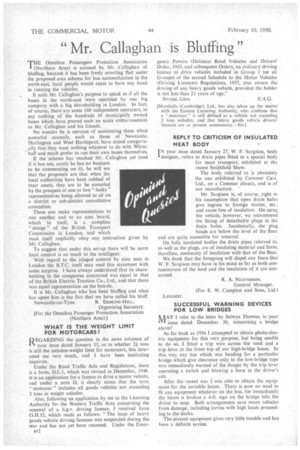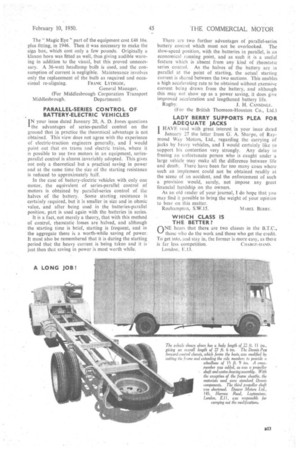" Mr. Callaghan is Bluffing "
Page 46

Page 47

If you've noticed an error in this article please click here to report it so we can fix it.
THE Omnibus Passengers Protection Association (Northern Area) is accused by Mr. Callaghan of bluffing, because it has been freely asserting that under the proposed area scheme for bus nationalization in the north-east, local people would cease to have any hand in running the vehicles.
It suits Mr. Callaghan's purpose to speak as if all the buses in the north-east were operated by one big company with a big shareholding in London. In fact, of course, there are some 160 independent operators, to say nothing of the hundreds of municipally owned buses which have proved such an acute embarrassment to Mr. Callaghan and his friends.
No wonder he is nervous of mentioning them when powerful councils, such as those of Newcastle, Darlington and West Hartlepool, have stated categorically that they want nothing whatever to do with Whitehall and much prefer to run their own buses themselves.
If the scheme has reached Mr. Callaghan yet (and if it has not, surely he has no business to be commenting on it), he will see that the proposals are that when the local authorities have been robbed of their assets, they are to be consoled by the prospect of one or two " lucky " representatives being allowed to sit on a district or sub-district consultative committee.
These can make representations to one another and to an area board, which in itself, is a complete " stooge" of the British Transport Commission in London, and which must itself implicitly obey any instruction given by Mr. Callaghan.
To suggest that under this set-up there will be more local control is an insult to the intelligent.
With regard to the alleged control by nine men in London the B.T.C. itself may read this statement with some surprise. Itave always understood that its shareholding in the companies concerned was equal to that of the British Electric Traction Co., Ltd., and that there was equal representation on the boards.
It is Mr. Callaghan who has been bluffing and what has upset him is the fact that we have called his bluff.
Newcastle-on-Tyne. R. ERSKINE-HILL, Organizing Secretary.
[For the Omnibus Passenger Protection Association (Northern Area).]
WHAT IS THE -WEIGHT LIMIT FOR MOTORCARS?
REGARDING •the question in the news columns of your issue dated January 13, as to whether 24 tons is still the unladen-weight limit for motorcars, this interested me very much, and I have been instituting inquiries.
Under the Road Traffic 'Acts and Regulations, there is a form, D.L.1, which was revised in December, 1948. It is an application for a licence to drive a motor vehicle, and under a note D, it clearly states that the term " motorcar " includes all goods vehicles not exceeding 3 tons in weight unladen.
Also, following an application by me to the Licensing Authority for the Western Traffic Area concerning the renewal of a h.g.v. driving licence, I received form G.H.32, which reads as follows: "The issue of heavy goods vehicle driving licences was suspended during the war and has not yet been resumed. Under the Erner
at' gency Powers (Defence) Road Vehicles and Drivers' Order, 1943, and subsequent Orders, an ordinary driving licence to drive vehicles included in Group 1 (or all Groups) of the second Schedule to the Motor Vehicles (Driving Licences) Regulations, 1937, also covers the driving of any heavy goods vehicle, provided the holder is not less than 21 years of age."
Stroud, Glos. E.A.G.
[Marshalls (Cambridge), Ltd., has also taken up the matter with the Eastern Licensing Authority, who confirms that a "motorcar" is still defined as a vehicle not exceeding 3 tons unladen, and that heavy goods vehicle drivers' licences are at present unnecessary.—Eol
REPLY TO CRITICISM OF INSULATED MEAT BODY IN your issue dated January 27, W. F. Sargison, body I designer, refers to drain pipes fitted to a special body for meat transport, exhibited at the recent Smithfield Show.
The body referred to is obviottsly the one exhibited by Commer Cars. Ltd., on a Commer chassis, and is of our manufacture.
Mr. Sargison is, of course, right in his assumption that open drain holes give ingress to foreign matter, etc., and cause loss of insulation. On using the vehicle, however, we recommend the fitting of detachable .plugs in the drain holes. Incidentally, the plug heads are below the level of the floor and are quite accessible for removal.
On fully insulated bodies the drain pipes referred to, as well as the plugs, are of insulating material and form, therefore, continuity of insulation with that of the floor.
We think that the foregoing will dispel any fears that W. F. Sargison may have in his mind as far as both contamination of the load and the insulation of it are concerned.
• R. A. NEAVERSON, General Manager. (For E. W. Campion and Sons, Ltd,) Leicester.
SUCCESSFUL WARNING DEVICES fOR LOW BRIDGES MAY I refer to the letter by Selwyn Thomas, in your Ivl issue dated December 30, concerning a bridge alarm?
As far back as 1936 I attempted to obtain photo-electric equipment for this very purpose, but being unable to do so, I fitted a trip wire across the road and a trip lever at the front top of our high-bridge buses. In this way any bus which was heading for a particular bridge which give clearance only to the low-bridge type was immediately warned of the danger by the trip lever operating a switch and blowing a horn in the driver's cab.
After the recent war I was able to obtain the equipment for the invisible beam: There is now no need to fit any equipment whatever on the bus, for immediately the beam is broken a 4-ft. sign on the bridge tells the driver to stop. Both arrangements save many vehicles from damage, including lorries with high loads proceeding to the docks.
The present equipment gives very little trouble and has been a definite saving. The "Magic Eye" part of the equipment cost L4g 16s. plus fitting, in 1946. Then it was necessary to make the sign box, which cost only a few pounds. Originally a klaxon horn was fitted as well, thus giving audible warning in addition to the visual, but this proved unnecessary. A 36-watt headlamp bulb is Used, and the consumption of current is negligible. Maintenance involves only the replacement of the bulb as required and occa sional re-aligning. FRANK LYTHGOE, general Manager, (For Middlesbrough Corporation Transport Middlesbrough. Department),
PARALLEL-SERIES CONTROL OF BATTERY-ELECTRIC VEHICLES
IN your issue dated January 20, A. D. Jones questions the advantages of series-parallel control on the ground that in practice the theoretical advantage is not obtained. This view does not agree with the experience of electric-traction engineers generally, and I would point out that on trams and electric trains, where it is possible to use two motors in an equipment, seriesparallel control is almost invariably adopted. This gives not only a theoretical but a practical saving in power and at the same time the size of the starting resistance is reduced to approximately half.
In the case of battery-electric vehicles with only one motor, the equivalent of series-parallel control of motors is obtained by parallel-series control of the halves of the battery. Some starting, resistance is ,certainly required, but it is smaller in size and in ohmic value, and after being used in the batteries-parallel position, part is used again with the batteries in series.
It is a fact, not merely a theory, that with this method of control, rheostatic losses are halved, and although the starting time is brief, starting is frequent, and in the aggregate there is a worth-while saving of power. It must also be remembered that it is during the starting period that the heavy current is being taken and it is just then that saving in power is most worth while. There are two further advantages of parallel-series battery control which must not be overlooked. The slow-speed position, with the batteries in parallel, is an economical running paint, and as suc.h it is a useful feature which is absent from any kind of rheostatic series control. As the halves of the battery are in parallel at the point of starting, the actual starting current is shared between the two sections. This enables a high accelerating rate to be obtained without excessive current being drawn from the battery, and although this may not show up as a power saving, it does give improved acceleration and lengthened battery life. Rugby. J. H. CANSDALE. (For the British Thomson-Houston Co., Ltd.)
LADY BERRY SUPPORTS PLEA FOR ADEQUATE JACKS
I HAVE read with great interest in your issue dated January 27 the letter from G. A. Sharpe, of Raymond Way Motors, Ltd., regarding the carrying of jacks by heavy vehicles, and I would certainly like to support his contention very strongly. Any delay in freeing an unfortunate person who is caught under a large vehicle may make all the difference between life and death. There have been far too many cases where such an implement could not be obtained readily at the scene of an accident, and the enforcement of such a provision would, surely, not impose any great financial hardship on the owners.
As an old reader of your journal, I do hope that you may find it possible to bring the weight of your opinion to bear on this matter. •
Roehampton, S.W.15. M ABEL BERRY, WHICH CLASS IS THE BETTER? nNE hears that there are two classes in the B.T.C., those who do the work and those who get the credit. TO get into, and stay in, the former is more easy, as there is far. less competition. CHARGE-11 ALND. London, E..13.




















































































